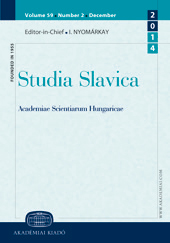Латынь и «словенский» в начальном образовании детей духовенства XVIII в.
Latin and "Slovenian" in the primary education of children of the 18th century clergy
Author(s): Ekaterina KislovaSubject(s): History of Church(es), Historical Linguistics, Eastern Slavic Languages, History of Education, 18th Century
Published by: Akadémiai Kiadó
Keywords: the Latin language; the Russian language; 18th century; the Church Slavonic language; Russian seminaries;
Summary/Abstract: This paper deals with the issue of using Latin and “Slavensky” (Russian and Church Slavonic) languages in the primary ecclesiastical education in the 18th century. By the 1740s, seminary education in Latin had established itself in Russia. But primary teaching of reading and writing in Russian and Church Slavonic remained traditional until the end of the 18th century, regardless of where the teaching was taking place: at home or at a Russian school at a seminary. The Russian schools were organized for teaching illiterate or semiliterate children. But by the end of the 18th century, several seminaries attempted to reorganise them into ecclesiastical schools where Russian would be the only language of instruction. Junior classes at seminaries were fully focused on teaching Latin, however, Latin was by no means a complete replacement for Russian. The main method of instruction was translation, and the administrations of many seminaries demanded attention to the quality of students’ translations into Russian. Therefore, Russian and Latin were functionally distributed in primary education. Only the Church Slavonic language was practically excluded from teaching after the primary courses of reading and church singing, and it preconditioned its conservation as a language used only for church services and led to the extinction of the hybrid form.
Journal: Studia Slavica Academiae Scientiarum Hungaricae
- Issue Year: 60/2015
- Issue No: 2
- Page Range: 315-329
- Page Count: 15
- Language: Russian
- Content File-PDF

